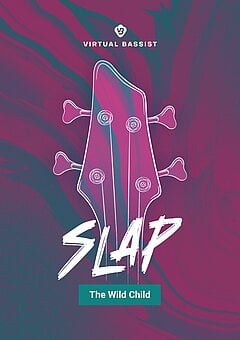How to Use Slap Bass Like 90s Funk Legends
Create authentic slap bass lines and make them shine in your songs, no matter what genre you choose.
APRIL 30TH, 2022
Read until the end of this tutorial article to find out how 90s funk legends created their slap bass lines and shaped a genre:
Nailing your bass lines
Slap bass works best as the primary focus of a song. Instead of assigning it the role of a conventional bass instrument, think of it as the bass and the melody — jumping between the two might sound messy, but it will help you better understand the technical challenges the best slap bassists excel at. Focusing on supporting the bass and melodic needs of a song simultaneously will yield more interesting results, plus it forces you to be more creative and jump around a bit!
There’s also the percussive role to consider: listen to any song released by slap bass legends and you’ll notice that not every note has that iconic twang. There are tons of regular notes played in between, which emphasizes the slapped notes and creates a ton of dynamic and timbral range in the bass performance. As a music producer, it’s tempting to add that signature slap on every single note, and for years this was the only option offered by sample libraries. But you know better — emphasizing the right notes is an art all its own and is essential in order to truly sell a slap bass performance.
This is challenging for bassists, even more so for producers, which is why we created Virtual Bassist SLAP: to make it easy to add authentic slap bass performances to your music without having to create them from scratch. If you want to dig into the classic sound from the early days of slap bass, try out the Miami preset and let it rip! Simply choose a starting note and select one of the many phrases available to you — then if you want to make adjustments, you can use the MIDI Drag & Drop feature to pull each phrase into your session and tweak it to your liking.
Slap bass production techniques
There are a few critical pieces of slap bass anatomy that must be present in order to do this artform justice. Number 1 is of course the trebly twang as the string is pulled or slapped, and there are a couple ways to ensure this sings out. The most obvious is using an EQ to push up the high end of the bass, though use bell curve and not a high shelf — otherwise too much “air” will come through in the extremely high frequencies. Another method which gives you more control is multiband compression, isolating the band where the twang comes through and manipulating the settings until you emphasize the initial hit and the buzz that follows.
Another important piece of the slap bass’s sound is the initial low-frequency punch to the attack. Listen to Marcus Miller’s Power and you’ll hear this almost immediately: that beautiful pop at the beginning of certain notes, making it jump out like a drum! You can achieve this with a compressor set to a slow attack and medium-fast release; if you want surgical precision, grab a transient control like Kilohearts’ Transient Shaper or Native Instruments’ Transient Master, run it in parallel with an aux track or other method, then dial up the attack, reduce the sustain and filter the high and low frequencies how you like. Fade in this punchy audio to your desired level and go from there!
Arranging and mixing
If you’re using a “normal” bass in EDM, your job is simpler: make the sub layer below your chords punch through with a bit of layering and distortion so it doesn’t get lost like a simple sine wave sub, or in the case of a drop, add the appropriate creative effects and dial up the compression. However, as an acoustic instrument, slap bass is very dynamic in nature — overdo the compression or effects and you destroy the sound, and layering typically isn’t a good fit.
That’s why producing with slap bass is first and foremost an arranging issue. You don’t want to create a dense mix, add in slap bass, and then try to carve out space for it — you’ll have to ruin the rest of the song to allow it to shine through! Instead, either cut out the slap bass entirely or simplify the arrangement to reduce the number of elements competing for attention. A good rule of thumb is that “wall of sound”-type mixes are a bad matchup as there are a lot of sustained sounds that consistently take up space. Whenever possible, keep the arrangement more dynamic: plucking or moving sounds, shorter snare tails, less reverb overall, etc. Basically, the closer you get to a small rock or funk band, the easier your job becomes!
Because they occupy a similar frequency range, the bass’s competition is, and almost always will be, the kick drum. If you’re replicating an acoustic band, many pro engineers solve this by emphasizing a different frequency range in each element, focusing on where the least overlap occurs. When that doesn’t completely solve things, light sidechain compression on the bass (triggered off of the kick) can work wonders, but this doesn’t work as well combined with slap bass. EDM producers have it somewhat easier — because the mix is more forgiving of heavier processing, you can apply sidechain EQ to other parts of the mix! Very few tools allow for this, but Trackspacer is a fantastic option.
Wrapping up
At this point, you have everything you need to add some spice to your songs with authentic slap bass! Its use is by no means limited to classic funk and the like — just check out our article, The Ultimate Guide to Nu Disco! With all the genre blending that occurs today, there’s plenty of room to add slap bass to any number of genres. There’s no harm in simply adding a touch of it here and there, but if you want to get the true slap bass experience, your best bet is always to refer back to the masters that made this sound iconic in the first place!
Remember also that you don’t have to pump out bass lines starting from nothing; Virtual Bassist SLAP gives you everything you need to drop the perfect bass line into your songs whenever you need, with the ability to tweak the notes however you need and keep things moving in your production workflow. Starting from existing material is one of the easiest and simplest ways to speed up your production, especially when you have the ability to effortlessly transform it to make it your own!
About the Author
Harry Lodes is a copywriter, marketing consultant and content writer for audio and ecommerce brands. He lives in the Philadelphia area, releasing Eastern/Western hybrid EDM under the artist name KAIRI hearkening back to his roots in Berklee College of Music.
Stay up to date
Sign up and we’ll send you an e-mail with product news and helpful stuff every now and then. You may unsubscribe at any time.
Defy Limits
We develop software solutions that enable people to create, consume and interact with music.



